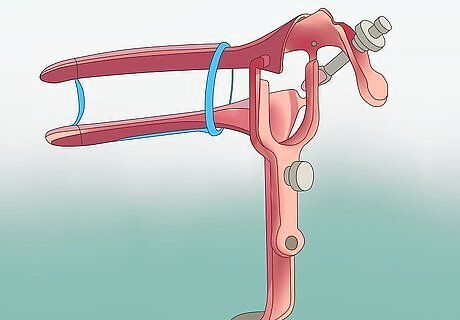
views
Preparing for Your First Appointment

Be prepared to answer some questions. It is normal to feel nervous when you are scheduled for your first visit to the gynecologist, but it's also important to be prepared so that you are able to get as much information from the doctor as possible. The first visit will include a lot of talking and you will be asked many questions about your health as the gynecologist gets to know you. The doctor will also ask about your family's medical history and whether you are sexually active or not. You may feel a little uncomfortable answering these questions but it is important that you are honest because this will allow the gynecologist to help you.

Avoid scheduling your appointment for during your period. Try to schedule the appointment for before or after your period, if possible. Being on your period may interfere with any tests that the gynecologist has to do, and the bleeding may make it difficult for them to see anything when conducting the physical exam, so the appointment may need to be rescheduled.

Avoid using any strong soaps or douching for at least 24 hours before the scheduled appointment. You should also avoid using any vaginal creams or products before the exam because these can mask any vaginal conditions and lead to false test results.

Make a list of any questions you might have. Make a list of all the questions that you're curious about or that have been worrying you. It's a good idea to write them down because you might forget them if you're nervous during the appointment. Your questions can include any issues to do with menstruation, offensive vaginal discharge, bleeding after intercourse, spotting in between periods, a lighter flow than normal, a heavy flow than normal, pelvic pain or any other unusual pain. Don't be embarrassed about any questions you want to ask - the gynecologist has heard it all before.
Knowing What to Expect

Be ready to provide some basic information. Before your exam, the doctor or nurse will ask the you some basic questions that are usually recorded in a file. The answers to these questions are used to provide a baseline of information that can be helpful for future visits. You may be asked questions like: When was your last period? How long do you bleed for? Are your periods regular? Do you feel pain during your periods? If so, how would you describe the pain? Do you experience any pain after sexual intercourse? Do you suffer from any discharge, itching or genital pain? Do you have any other medical issues? Is there a history of any medical conditions in your family? Do you have a specific method of birth control that you are using? When was your last pregnancy? Do you think that you are pregnant? Are you trying to have a baby? What method do you use to prevent sexually transmitted diseases? Do you have more than one sexual partner?

Be prepared to talk about your medical history. Other questions that may be asked will have to do with your medical history. This includes whether you have been admitted to hospital before, have has any surgery in the past, any miscarriages, how many children you have, whether you smoke and whether you a have a problem holding your urine. The doctor may also want to review the contraceptive that you are currently using and will ask you if you're happy with it and whether it's causing any side effects.

Be ready to get undressed. It is recommended that you wear clothes that can be easily removed to make it easier for the doctor to do the examination. Usually, you will be provided with a hospital gown and a drape sheet to cover yourself while the exam is being carried out. The gynecologist will ask you to lie down on the bed so that the examination can be performed. If it makes you feel more comfortable, you can ask to have a family member or friend in the exam room with you.

Allow the gynecologist to do a breast exam. First the gynecologist will do a breast examination - this helps to identify any irregularities like lumps. The doctor will use their hands to palpate the breast one at a time. This is a good opportunity for you to learn how to do a self-breast examination.

Know what to expect during the pelvic exam. When it's time for the pelvic exam, you will be asked to rest your heels in the metal stirrups or place your knees on a knee rest. You will then be asked to move your hips to the edge of the couch, as this provides a good angle for the gynecologist to do the pelvic exam. You will be encouraged to spread your knees wide apart and to breathe deeply in and out to try to relax. This may be difficult for the first visit but it becomes easier with subsequent ones. Try to relax your vaginal and abdominal muscles, as this will make the exam more comfortable. Don't worry about feeling too exposed as you will usually be provided with a drape sheet to keep you covered throughout the examination. Don't hesitate to ask the doctor if you have any questions about what they're doing.

Understand what will happen during the external and speculum exam. The doctor will also perform an external examination of the genitalia, where they will assess the external parts of the vagina such as the vulva, opening of vagina and the folds. The doctor will check for any signs of irritation, redness, discharge genital warts and cysts. The doctor will then perform a speculum examination where a sterile plastic or metal speculum is inserted into the internal part of the vagina. The speculum is then opened by the doctor and this helps to separate the walls of the vagina to allow the doctor to see the cervix. You may feel some discomfort when the speculum is inserted, however most doctors will warm the speculum and lubricate it to make it more comfortable for you. The gynecologist will then inspect the cervix to look for any abnormalities like irritation, abnormal discharge, or any growths.
Prepare for a vaginal swab or pap smear. The doctor may take a vaginal swab to test for different sexually transmitted diseases. This includes gonorrhea, chlamydia and human papilloma virus. The doctor may also do a pap smear by using a tiny brush or spatula to collect some cells from the cervix. The cells are then taken to the laboratory where they are tested for cancerous or precancerous cells. When the doctor removes the speculum, the walls of the vagina are checked for irritation and redness.

Be ready for a little bleeding. It is possible (though not certain) that you will experience a little bleeding or spotting after the examination is done. This is because the different instruments that are inserted into the vagina during the examination may cause bruising or bleeding. Therefore, it is advisable to bring a pad or a panty liner to the exam to prevent staining your clothes.

Get dressed and ask any further questions. When the doctor has finished doing the physical exam, you will be allowed to change back onto your own clothes. At this point, feel free to ask any additional questions you might have. After the exam, you may need to set up an appointment to discuss the results of any tests. Most laboratory tests take between 3 to 14 days before there are any results. The one exception is a pregnancy test, the result of which are usually available by the end of the visit. You doctor will be happy to walk you through your test results and answer any questions.



















Comments
0 comment